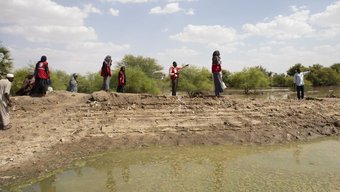Categories
Sudan country profile
BACKGROUND
The Republic of Sudan, the third largest country on the African continent, is located in North Africa at the crossroads of Sub-Saharan Africa and the Middle East. The White and Blue Niles meet in Khartoum, the capital city of Sudan, and merge to become the Nile River that flows all the way to the Mediterranean Sea via Egypt. Its terrain includes desert in the far north and fertile land in the Nile valleys. A large part of the economy comes from the agricultural sector, which provides livelihoods for two-thirds of Sudanese people.
The climate ranges from hyper-arid and desert temperatures in the north to tropical wet-and-dry in the far southwest. Rainfall in Sudan is unreliable and erratic, with great variation experienced between northern and southern regions. Parts of the country experience harsh sandstorms, known as haboob, which can be known to completely block out the sun. Other climate-related hazards affecting Sudan include floods, drought, earthquakes, and wildfires. It is also susceptible to disease outbreaks and insect infestations that affect the health of people and of their crops.
Desertification, land degradation, soil erosion, and deforestation are all major environmental issues in Sudan and are expected to increase vulnerability and exposure to climate hazards. The country faces significant challenges including housing a large number of displaced people, including refugees from neighboring countries, a volatile economic situation, increased climate variability, malnutrition, gender inequality, and the risk of relapse back into potential conflict like that of 2019.
INFORM RISK INDEX (2022)
Hazard and exposure: 5.7 | Vulnerability: 7 | Lack of coping capacity: 6.7 | Total: 6.4 (high) | Rank: 15
HAZARDS COVERED BY ANTICIPATION
Riverine floods | Drought
EXPERIENCE ON ANTICIPATION
- Start Network partners are active in the country and have received funding allocation from Start Fund since 2016. In June 2021, Start Network reached 82,802 people ahead of anticipated floods in the Blue Nile, Sennar, Khartoum, and White Nile states (alert 529).
- In 2017, FAO released $400,000 to respond to an alert from its Early Warning Early Action (EWEA) systems about the onset of a drought in Kassala. The project targeted 5,000 households and actions included animal feed distributions, livestock vaccinations, and training on destocking.
- The Sudanese Red Cross, with support from the Danish Red Cross, is developing anticipatory actions ahead of riverine flooding.
Read more about projects, resources, activations and working groups below.












